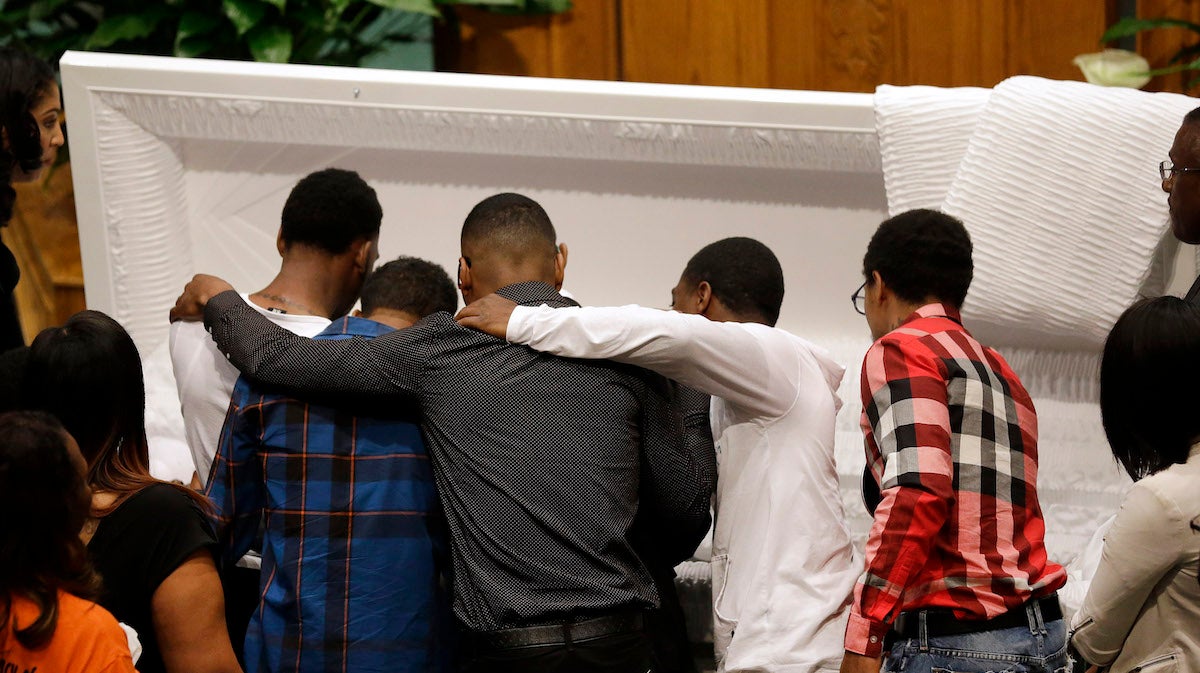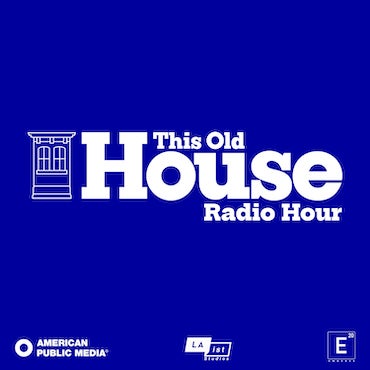Message of fear starts young for black boys: ‘There are no toys in jail’

Mourners embrace as they gather in front of the casket containing the body of Freddie Gray before his funeral, Monday, April 27, 2015, at New Shiloh Baptist Church in Baltimore. Gray died from spinal injuries about a week after he was arrested and transported in a Baltimore Police Department van. (AP Photo/Patrick Semansky)
The neighborhood I taught in is just six blocks away from where Freddie Gray grew up. The Head Start students I had back then are now exactly the same age as Gray was when his spine was fatally severed.
While I fear violence, I understand resistance against oppression. What is happening in Baltimore is the kind of messy resistance that many Americans rally behind when it happens in other countries, but it’s the kind that is far too scary when it happens in our own backyard. The kind that’s much harder to accept because we feel the pain, the destruction, the heat, and the anger directly.
I wrote this story back in December, shortly after a jury declined to indict a New York City police officer following the choking death of Eric Garner.
I was struggling to make sense of why the news kept drawing me back to my days in Baltimore. When I wrote this, I was seeing my students’ faces layered over those of Michael Brown, Eric Garner and Oscar Grant.
I had no idea that the next name would come from the very same streets my preschoolers played in.
When I taught in Baltimore City in the 1990s, the oft-quoted crime statistics of the city noted that seven out of every 10 black males would end up in the criminal justice system as adults. I have no idea if this was an accurate statistic, but it’s one I heard it all the time. And all of the children I taught were African-American.
The West Baltimore neighborhood struggled with poverty, with crime, with under-resourced schools and health care systems, and with limited opportunities. But it was also brimming with promise.
The families were vibrant. They loved their little boys with a passion. They watched over their play, the friends they made, and their early education. They showed up for parent conferences, read the books I sent home to their children, and worked hard to give them a “Head Start.”
The boys themselves, three and four and five years old, were so bright, so inquisitive, so engaging, and so very, very funny. They kept me on my toes and made my job as rewarding as it was exhausting. I didn’t have children of my own back then, so I loved those kids with my whole heart.
Those preschoolers are now in their early 20s. Little Jay Jay, Jonathan, Delonte, Jared, Chelin, Bruce and friends are now grown black men. And every time I hear about the shooting of an unarmed black male, their faces are the ones I see layered on top of Trayvon Martin, Michael Brown, Tamir Rice, Oscar Grant, and Eric Garner.
I wonder how the system could fail them, and fail us all, so miserably.
‘There are no toys in jail’
I think back to the police officer who came in to speak to my class one day. Knowing “community helpers” is a big theme in preschool, and I wanted to show the kids that people just like them kept their community going. I was so excited when I learned the officer coming in to speak was an African-American woman. So excited, that is, until she started to speak.
“How many of you know someone in jail?” Almost every tiny brown hand flew into the air.
“Well, those grown-ups are breaking the law, and that’s why they went to jail. Drugs are against the law. If your mommy breaks the law, she will go to jail. If your daddy breaks the law, he’ll go to jail. If you break the law, you will go to jail too. There are no toys in jail.”
No toys in jail. She pointed to them as she threatened my wide-eyed four year olds with prison. Twenty years later, it still remains one of the lowest points in my teaching career. I allowed her to come into our safe space and talk to my preschoolers like criminals. I realized that life training for them started right then and there, if it hadn’t already. And I had invited it in.
Black Lives Matter?
I think back to that incident because Michael Brown, Trayvon Martin, Tamir Rice, Oscar Grant and Eric Garner? They all went to school too. They all sat in classrooms for years, learning who they were in our system, who was in power and who society thought they were. The lessons might not have been as explicit as the one my preschoolers received that day, but they were there just the same.
And in the same moment, I realize something else.
Darren Wilson, George Zimmerman, Timothy Loehmann, Johannes Mehserle, and Daniel Pantaleo all went to school too. In different classrooms, in different schools. Did a police officer come in to talk to them as preschoolers too? If so, what did she say to them?
Because we teachers have both the shooters and the victims right in front of us, hour after hour, year after year after year.
We teach them about math and reading and science, but we also create histories as we teach them the unspoken lessons about what their role is and how the system works. About who’s in power and who isn’t. About who matters and who doesn’t.
Deafening call to action
As educators, we have them right in the palm of our hands in the years when it matters most. It’s both a gift and a deafening call to action.
We didn’t build the system, but even with the best intentions, we’ve had a hand in reproducing it.
What lessons are they learning from us about fairness, about who matters, about speaking up and working for change? Because we will continue to see them, right in front of our eyes, year after year, both the shooters and the victims.
So what do we do to upend the unjust system and harness the promise? The opportunity? The responsibility we’ve been given?
Apologies
What I did the day after the officer left my class, was to simply apologize. I tearily told my young students that I had no idea that the officer would speak that way to them, and if I had known, she would never have been allowed to speak.
I told them they mattered. That they were smart and curious and creative and funny. That they were good friends. And that they deserved respect.
But if they remember the incident 20 years later I’m sure they remember the officer’s words more than mine, because they were shocked. And because at their request, she also showed them her gun.
Which makes me realize, as educators, the lessons we pen and the words we speak have to be mightier than the swords, guns, or badges the system wields over our students. We must speak louder, name the injustices our students face, and construct a better history for us all.
Because it all starts while they’re very, very young.
This piece was originally published in the Berkeley Education Review.
WHYY is your source for fact-based, in-depth journalism and information. As a nonprofit organization, we rely on financial support from readers like you. Please give today.

